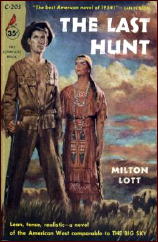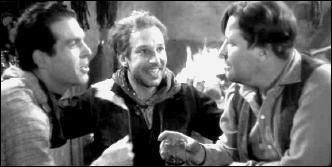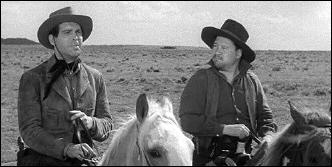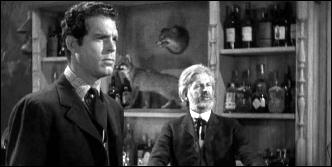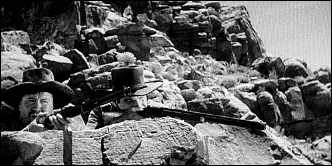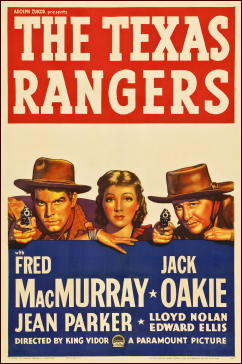Reviewed by JONATHAN LEWIS:

WICHITA. Allied Artists, 1955. Joel McCrea, Vera Miles, Lloyd Bridges, Wallace Ford, Edgar Buchanan, Peter Graves, Keith Larsen, Walter Coy, Jack Elam. Director: Jacques Tourneur.
The first time the viewer sees now legendary figure Wyatt Earp (Joel McCrea) in Wichita, he’s an absolutely miniscule figure on horseback perched on a hill off in the distance.
A solitary man overwhelmed by nature, Earp is initially portrayed as extraordinarily reluctant to be the arbiter of law and order in the rapidly growing city of Wichita, Kansas. Earp’s also got a strong fatalistic streak, going so far as to tell a potential love interest after a bank robbery that “things like that are always happening†to him. As if he were just an object swept to and fro by the winds of History.
Directed by Jacques Tourneur (Cat People, Out of the Past), Wichita is not only quite good Western, it’s also a superbly well-crafted character study of how frontier violence fundamentally alters the course of one man’s life. With a supporting case that includes a youthful Lloyd Bridges as a villain and Peter Graves as Earp’s brother, Morgan, the film is definitely worth a look.

The story follows Earp (McCrea) as he journeys, both literally and metaphorically, from a lonesome figure on horseback to a married man tasked with establishing law and order in Kansas. Soon after the film begins, Earp encounters a cowboy encampment. After some initial pleasantries, his relationship with the men begins to sour – and how! – after two of the men attempt to steal from him as he sleeps. Although this initial encounter is brief, it sets the stage for what is to come.
Earp journeys onward alone, stopping briefing in front of a signpost indicating Wichita is ahead. The sign also notably states, in all capital letters, that “Everything Goes in Wichita.†Soon two fast moving stagecoaches barrel down on him, pushing him off to the side. The first stagecoach has a banner on the back with the very same words, while the second has one that reads, “Wine, Women, Wichita.†From that moment onward, the viewer knows that the rapidly expanding city is going to be both a somewhat lawless town, but also a frontier town where a man can reinvent himself.

Earp’s plan is to be a businessman in town. That plan goes by the wayside once he witnesses the aforementioned cowboys arrive in town and, in a drunken frenzy, shoot up Wichita, killing an innocent young boy in the process.
That’s when Earp decides he will take the mayor up on his offer and become a U.S. Marshal. Supporting him in his endeavor is Bat Masterson (Keith Larsen). The rest of the movie revolves around not only the conflict between Earp and the cowboys, but also a growing rift between Earp and Sam McCoy (Walter Coy) over Earp’s strong-arm tactics. Earp also falls for McCoy’s daughter, Laurie (Vera Miles) in a somewhat clichéd subplot that doesn’t really do much for the film, but may have been intended as a box office draw.

There are several scenes in Wichita that merit particular consideration. The first is Earp’s initial encounter with the cowboys. When he first meets them, he’s elevated on horseback. They are sitting. We quickly learn he’s a stoic figure, with his first words to them (and in the movie) as follows: “Howdy! My name’s Earp, Wyatt Earp.†While all of the cowboys are dressed in a dark colors, Earp is wearing a clean, bright red shirt. This marks the beginning of a personal journey that will culminate in his fight against the darkness and disorder symbolized by these ragged men.
The sequence in which the cowboys shoot up the town, injure a woman, and kill a young boy through carelessness also is likewise worth watching closely. These events prompt Earp to accept the position as U.S. Marshal. Look for the notable, stark contrast between the bright saloon and the dark, foreboding street.

Inside the saloon, there are many women, resplendent in a multitude of colors. Outside, on the dusty street, there are loud men in dark clothes engaging in recklessness and violence. By stepping out into the grey netherworld of the Wichita streets, Earp becomes the de facto protector of the town’s innocent women and children and a protector of Wichita’s desire for domesticity.
Finally, there’s a harrowing scene in which the cowboys shoot Sam McCoy’s wife. Again, the killing wasn’t so much intentional, as the result of lawlessness. The gunmen ride in front of McCoy’s house, shooting into it. We see McCoy’s wife fall to the ground and bullet holes lodged in the family house’s front door. This senseless act of violence again prompts Earp into action, making the final break between Earp the businessman and Earp the lawman.
Wichita has a lot to recommend it. With a running time of a little less than ninety minutes, the film has decent pacing and enough action to keep a viewer engaged. McCrea is generally very good in this, as is Peter Graves.
The film’s biggest downside is the fact that the plot is just a bit too predictable. Much like in Law and Order, which I reviewed here, the hero is a U.S. Marshal who defeats the bad guys and gets the girl. What sets Wichita apart, however, is its significantly better cinematography and use of symbolism to tell the story of Wyatt Earp before he arrived in Dodge City.
